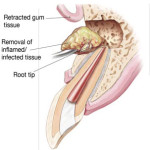 The most common procedure we perform in our office is the nonsurgical root canal, often referred to as a root canal.
The most common procedure we perform in our office is the nonsurgical root canal, often referred to as a root canal.
Root canal therapy may be required if the nerve in the tooth has become irritated and sensitive to temperature changes and biting. Other times a tooth can crack or chip, leading to a situation where the nerve becomes inflamed. In extreme circumstances, the nerve of the tooth may die, leading to pain when chewing, and even swelling in the mouth or cheek.
During a root canal, we profoundly anesthetize your tooth, remove the nerve  tissue, disinfect the space and then seal it. All of this is done under the microscope in an effort to be as accurate as possible.
tissue, disinfect the space and then seal it. All of this is done under the microscope in an effort to be as accurate as possible.
From time to time, a root canal may not have a favorable outcome. In the event of this, we have other treatment options available. The first is to revise the initial treatment, which we call nonsurgical retreatment. The steps are similar to the initial treatment, except the root filling material is removed and then the process is essentially repeated.
 The other option is to perform a surgical procedure to remove the infected tissue, and seal the root from the bottom of the tooth. This is known as apicoectomy.
The other option is to perform a surgical procedure to remove the infected tissue, and seal the root from the bottom of the tooth. This is known as apicoectomy.
Both treatments may be available, and after consultation and discussion with you,we will proceed with the most favorable option.
In addition, you may be sent to see us for consultation or a diagnostic visit. Sometimes that will lead to treatment, and from time to time, it will not. We only provide endodontic treatment when it is absolutely necessary.
Photo credits: American Association of Endodontists

